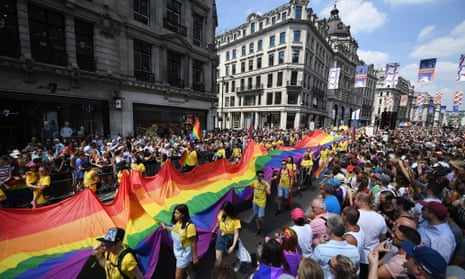Homophobic and transphobic hate crimes, including stalking, harassment and violent assault, have more than doubled in England and Wales over five years, a Guardian analysis has shown.
The rate of LGBT hate crime per capita rose by 144% between 2013-14 and 2017-18. In the most recent year of data, police recorded 11,600 crimes, more than doubling from 4,600 during this period.
Transphobic attacks have soared in recent years, trebling from 550 reports to 1,650 over the period examined. Almost half (46%) of these crimes in 2017-2018 were violent offences, ranging from common assault to grievous bodily harm.
The findings come after two women were attacked on a bus in London for refusing to kiss in front of a group of men. The incident sparked widespread condemnation.
“When this happened, we were really angry,” says Melania Geymonat, 28. “And we decided to tell the story, because this situation needs to change, and maybe this helps a little. For me, it was a moral obligation. Like, this needs to stop. This was a terrible episode, and maybe [if] we say something, we can contribute to something bigger.”
In 2017-18, 40% of anti-gay and lesbian hate crime in England and Wales were violence against a person. And more recent data released to the Guardian by Essex, Kent and Merseyside police forces appears to show the trend continuing.
In Kent, police reported a 42% annual rise in the number of LGBT hate crimes in 2018-2019, while Essex and Merseyside reported increases of 35% and 25% respectively.
Campaigners said the rise could partly be down to better reporting but added that hatred was growing on British streets because of the rise of rightwing populism.
Taz Edwards-White, an alliance manager at Metro, an equalities and diversity organisation, said the hate crime figures were likely to be “the tip of the iceberg”.
She added: “There is a tension, and even within our own LGBT community there is a tension. I believe it’s a direct result of people feeling unsafe due to rise of the rightwing political movement.
“What we see in our services is lots of people experience day-to-day verbal attacks or violence and aggressive language and homophobic attitudes … We do believe the political climate has had an impact: people feel unsafe. What is happening in central government and all the scapegoating has an effect. We saw a spike [in racist attacks] after Brexit and there has been a steady increase since then.”
Jessica White, who leads hate crime reporting work at the LGBT Foundation, an organisation based in Manchester, said the rise could be linked to an increased awareness of hate crime and its reporting.
She said: “More and more, we are having people come to us who have been experiencing hate for a long period of time – prolonged abuse, often in their communities – who are finally coming forward to report. These will often be people who have been experiencing hate for years, see a poster on the tram, on the bus or on the train and realise that it’s not okay and there is support there for them.”
The biggest increase in hate crime was in West Yorkshire, with the rate increasing by 376% between 2013-2014 and 2017-2018. On a regional level, the rate of anti-gay and lesbian crime trebled in Yorkshire and the Humber and the South East.
The analysis excluded all police force areas where fewer than 100 sexual orientation hate crimes were recorded in 2013-2014, and worked out the increase in the rate of crimes per 10,000 people up to 2017-2018.
Nick Antjoule, the head of hate crime services at Galop, an LGBT anti-violence charity, said the Guardian analysis came as no surprise. He said: “We’ve seen a big spike in the scale and seriousness of hate crimes.”
Antjoule called for more specialist services to support LGBT people who experienced hate crimes, pointing to previous research by the Metropolitan police that showed victims of homophobic hate crime were more likely to experience more serious violence than victims of other forms of hate crimes.
He added: “In the last several years, there’s been a really huge spike in transphobic hostility that people are facing from their neighbours, public transport and online … It’s something we need to see changed so people can live their lives openly.”
Laura Russell, the director of campaigns policy and research at Stonewall, said the rise in hate crimes showed there was a long way to go before the LGBT community was accepted in British society. “We are still not living in a society where every LGBT person is able to achieve their potential and not have to live in fear of physical or verbal violence for being who they are,” she said.
In Hampshire, where two actors were recently attacked in a high-profile homophobic incident, the rate of homophobic hate crime increased 189% in the last five years – significantly higher than the England and Wales rate.
Hampshire police recorded 424 crimes in 2017-2018, up from 143 five years previously.
Race has consistently accounted for the majority of hate crimes reported to police in England and Wales. In the most recent year of data, race was a factor in 76% of crimes, compared to just over 12% in the sexual orientation category.
